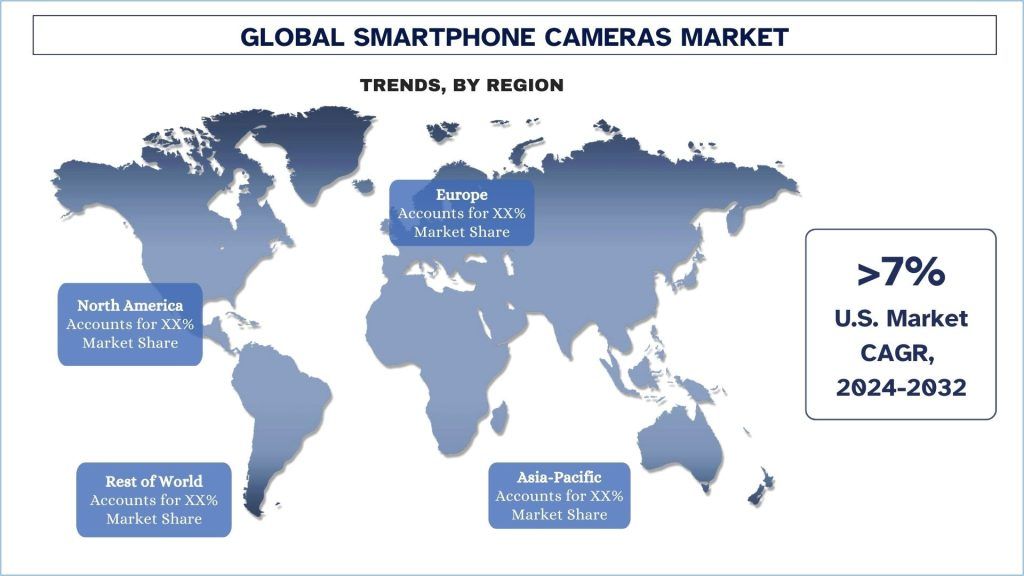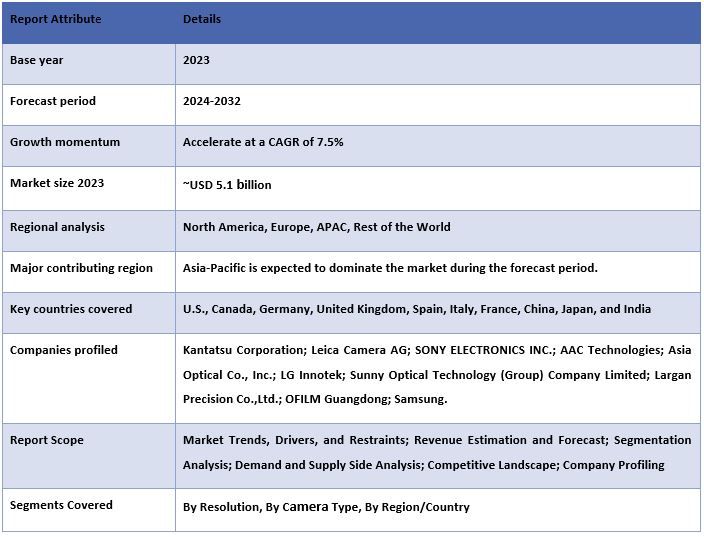- Home
- About Us
- Industry
- Services
- Reading
- Contact Us
Smartphone Camera Market: Current Analysis and Forecast (2024-2032)
Emphasis on Resolution (Below 8MP, 8-16MP, and Above 16MP); Camera Type (Single-Lens, Double-Lens, and Multi-Lens); and Region/Country
Smartphone Camera Market Size & Forecast
The smartphone camera market was valued at approximately ~USD 5.1 billion in 2023 and is expected to grow at a strong CAGR of around 7.5% during the forecast period (2024-2032) owing to the rapidly increasing technological developments in smartphones, and the rising adoption of camera lenses globally.
Smartphone Camera Market Analysis
Smartphone cameras have turned into one of the fastest-growing markets and have had a great deal of impact on the overall market and consumer choices. This concerns the latest features that are found on smartphones such as the multi-lens system, high-resolution sensors, and other computational photography that have made the smartphone devices compete more with modern camera devices. The increase in use of the smartphones and other social networking sites for sharing photographs and other artistic work, and people’s demand for improved quality pictures, especially for display, have made it compulsory for producers to work on the camera at constant intervals. Starting from people who like to take occasional pictures from their mobile phones for fun to professional photogs who may require enhanced video quality, there is a market for everything. With brands starting to feel the heat in the market like Apple, Samsung, and Google among others the effort to improve camera features including night mode, stabilization, and live editing cannot be overemphasized. It illustrates why the smartphone camera is now an omnipresent component of the smartphone picture and one that continues to create ongoing markets.
Recent Developments in the Market:
In September 2024, Samsung is reportedly planning to launch its rollable smartphone in the second half of the next year. The device is expected to feature a 12.4-inch screen and an under-display camera that conceals the front camera for selfies and video calls, according to 9to5Google. Samsung unveiled a rollable display of similar size at the SID Display Week 2024 event, and it seems the company may be incorporating that screen technology into the rollable smartphone.
In July 2024, Realme announced a partnership with Sony while launching its Realme 13 Pro 5G AI camera phone series, as the Chinese smartphone maker bets on AI being the “new battlefield of mobile imaging.” Realme shared that its new AI camera in the series is the first to be powered by the Sony LYT-701 sensor and the Sony LYT-600 Periscope lens.
Smartphone Camera Market Trends
This section discusses the key market trends that are influencing the various segments of the smartphone camera market, as identified by our team of research experts.
The Multi-lens Segment Transforming Industry
Premium features and innovations in the multi-lens segment of the smartphone camera have tremendously improved user experience while augmenting the photography feature. Manufacturers have simultaneously incorporated complex lens configurations, including wide-aperture, telephoto, macro, and ultra-wide-aperture, enabling users to capture all forms of scenes in photography. Over the years, advancements in optical design such as lens design and better-quality sensors led to a clearer picture, the least distortion, and better low-light environment capturing. Also, ‘Depth of Field’ in portrait and ‘Live’ photography works due to the improved computational photography and advanced algorithms controlling AI-focused cameras integrating multiple images from different camera lenses. Beneath these adaptations, not only do users benefit from higher degrees of creative freedom, but it has also become possible for consumers to produce near-professional-quality content solely with a smartphone in their hand. Therefore, the multi-lens segment remains popular among consumers who occasionally take photos and beautiful bloggers, which confirms the importance of this segment in the constant development of mobile photography.

Asia-Pacific is expected to grow at a significant rate in the forecast period
The growth in the smartphone camera specifically in the market in APAC has been characterized by radical technologies that seek to improve the quality of the images shot and ease of use. Top-of-the-range models have multiple lens systems to enable different types of photos all in one, wide angle, telephoto, and macro among others. This makes it possible for a broad range of users, from the casual one who just shoots snapshots to the professional who will be using it in their photoshoots.
In May 2024, Motorola India teased the launch of another budget-friendly smartphone. The teaser video was released on Motorola India’s official social media handle, and it reveals that the phone will have a 50MP camera at the back with a vegan leather design. The video teaser describes the phone as the best camera phone in its segment, and it will come with a dual rear camera setup and a curved display.
In February 2024, Xiaomi’s latest flagship handset was launched in China ahead of an expected Mobile World Congress appearance in Barcelona next week. The 14 Ultra’s headline feature is a Leica main camera with a new Sony 1-inch sensor. The camera tech in the Ultra steals the show here, championed by a 50-megapixel main based around Sony’s LYT-900 1-inch-type image sensor and sporting a fast F1.63 aperture, a 23-mm-equiv focal length, and optical image stabilization.

Smartphone Camera Industry Overview
The smartphone camera market is competitive, with several global and international market players. The key players are adopting different growth strategies to enhance their market presence, such as partnerships, agreements, collaborations, geographical expansions, and mergers and acquisitions. Some of the major players operating in the market are Kantatsu Corporation; Leica Camera AG; SONY ELECTRONICS INC.; AAC Technologies; Asia Optical Co., Inc.; LG Innotek; Sunny Optical Technology (Group) Company Limited; Largan Precision Co.,Ltd.; OFILM Guangdong; Samsung.
Smartphone Camera Market News
In July 2024, HMD Crest and Crest Max launched in India with a 50MP selfie camera. It has a triple rear camera unit, comprising a 64MP primary camera featuring a Sony sensor, a 5MP ultra-wide camera, and a 2MP macro sensor to elevate the photography experience.
In March 2023, OPPO unveiled its latest flagship smartphone series, the Find X6 series, in China. Featuring a new Three Main Camera System comprising a Wide Camera with a large 1-inch sensor, a groundbreaking Periscope Telephoto Camera, and a high-quality Ultra-Wide Camera, the Find X6 series evolves smartphone imaging technology beyond the ‘main camera’ system to an all-new Three Main Camera era.
Smartphone Camera Market Report Coverage

Reasons to buy this report:
- The study includes market sizing and forecasting analysis validated by authenticated key industry experts.
- The report presents a quick review of overall industry performance at one glance.
- The report covers an in-depth analysis of prominent industry peers with a primary focus on key business financials, product portfolios, expansion strategies, and recent developments.
- Detailed examination of drivers, restraints, key trends, and opportunities prevailing in the industry.
- The study comprehensively covers the market across different segments.
- Deep dive regional level analysis of the industry.
Customization Options:
The global smartphone camera market can further be customized as per the requirement or any other market segment. Besides this, UMI understands that you may have your own business needs, hence feel free to connect with us to get a report that completely suits your requirements.
Table of Content
Research Methodology for the Smartphone Camera Market Analysis (2024-2032)
Analyzing the historical market, estimating the current market, and forecasting the future market of the global smartphone camera market were the three major steps undertaken to create and analyze the adoption of smartphone camera in major regions globally. Exhaustive secondary research was conducted to collect the historical market numbers and estimate the current market size. Secondly, to validate these insights, numerous findings and assumptions were taken into consideration. Moreover, exhaustive primary interviews were also conducted, with industry experts across the value chain of the global smartphone camera market. Post assumption and validation of market numbers through primary interviews, we employed a top-down/bottom-up approach to forecasting the complete market size. Thereafter, market breakdown and data triangulation methods were adopted to estimate and analyze the market size of segments and sub-segments of the industry pertains to. Detailed methodology is explained below:
Analysis of Historical Market Size
Step 1: In-Depth Study of Secondary Sources:
A detailed secondary study was conducted to obtain the historical market size of the smartphone camera market through company internal sources such as annual reports & financial statements, performance presentations, press releases, etc., and external sources including journals, news & articles, government publications, competitor publications, sector reports, third-party database, and other credible publications.
Step 2: Market Segmentation:
After obtaining the historical market size of the smartphone camera market, we conducted a detailed secondary analysis to gather historical market insights and share for different segments & sub-segments for major regions. Major segments are included in the report, such as resolution, camera type, and regions. Further country-level analyses were conducted to evaluate the overall adoption of testing models in that region.
Step 3: Factor Analysis:
After acquiring the historical market size of different segments and sub-segments, we conducted a detailed factor analysis to estimate the current market size of the smartphone camera market. Further, we conducted factor analysis using dependent and independent variables such as resolution, camera type, and regions of the smartphone camera market. A thorough analysis was conducted for demand and supply-side scenarios considering top partnerships, mergers and acquisitions, business expansion, and product launches in the smartphone camera market sector across the globe.
Current Market Size Estimate & Forecast
Current Market Sizing: Based on actionable insights from the above 3 steps, we arrived at the current market size, key players in the global smartphone camera market, and market shares of the segments. All the required percentage shares split and market breakdowns were determined using the above-mentioned secondary approach and were verified through primary interviews.
Estimation & Forecasting: For market estimation and forecast, weights were assigned to different factors including drivers & trends, restraints, and opportunities available for the stakeholders. After analyzing these factors, relevant forecasting techniques i.e., the top-down/bottom-up approach were applied to arrive at the market forecast for 2032 for different segments and sub-segments across the major markets globally. The research methodology adopted to estimate the market size encompasses:
The industry’s market size, in terms of revenue (USD) and the adoption rate of the smartphone camera market across the major markets domestically.
All percentage shares, splits, and breakdowns of market segments and sub-segments.
Key players in the global smartphone camera market in terms of products offered. Also, the growth strategies adopted by these players to compete in the fast-growing market.
Market Size and Share Validation
Primary Research: In-depth interviews were conducted with the Key Opinion Leaders (KOLs) including Top Level Executives (CXO/VPs, Sales Head, Marketing Head, Operational Head, Regional Head, Country Head, etc.) across major regions. Primary research findings were then summarized, and statistical analysis was performed to prove the stated hypothesis. Inputs from primary research were conso0lidated with secondary findings, hence turning information into actionable insights.
Split of Primary Participants in Different Regions

Market Engineering
The data triangulation technique was employed to complete the overall market estimation and to arrive at precise statistical numbers for each segment and sub-segment of the global smartphone camera market. Data was split into several segments and sub-segments after studying various parameters and trends in the areas of the resolution, camera type, and regions in the global smartphone camera market.
The main objective of the Global Smartphone Camera Market Study
The current & future market trends of the global smartphone camera market were pinpointed in the study. Investors can gain strategic insights to base their discretion for investments on the qualitative and quantitative analysis performed in the study. Current and future market trends determined the overall attractiveness of the market at a regional level, providing a platform for the industrial participant to exploit the untapped market to benefit from a first-mover advantage. Other quantitative goals of the studies include:
- Analyze the current and forecast market size of the smartphone camera market in terms of value (USD). Also, analyze the current and forecast market size of different segments and sub-segments.
- Segments in the study include areas of the resolution, camera type, and regions.
- Define and analyze the regulatory framework for the smartphone camera
- Analyze the value chain involved with the presence of various intermediaries, along with analyzing customer and competitor behaviors of the industry.
- Analyze the current and forecast market size of the smartphone camera market for the major region.
- Major countries of regions studied in the report include Asia Pacific, Europe, North America, and the Rest of the World
- Company profiles of the smartphone camera market and the growth strategies adopted by the market players to sustain in the fast-growing market.
- Deep dive regional level analysis of the industry.
Frequently Asked Questions FAQs
Q1: What is the smartphone camera market's current market size and growth potential?
Q2: What are the driving factors for the growth of the smartphone camera market?
Q3: Which segment has the largest share of the smartphone camera market by resolution?
Q4: What are the emerging technologies and trends in the smartphone camera market?
Q5: Which region will dominate the smartphone camera market?
Related Reports
Customers who bought this item also bought









